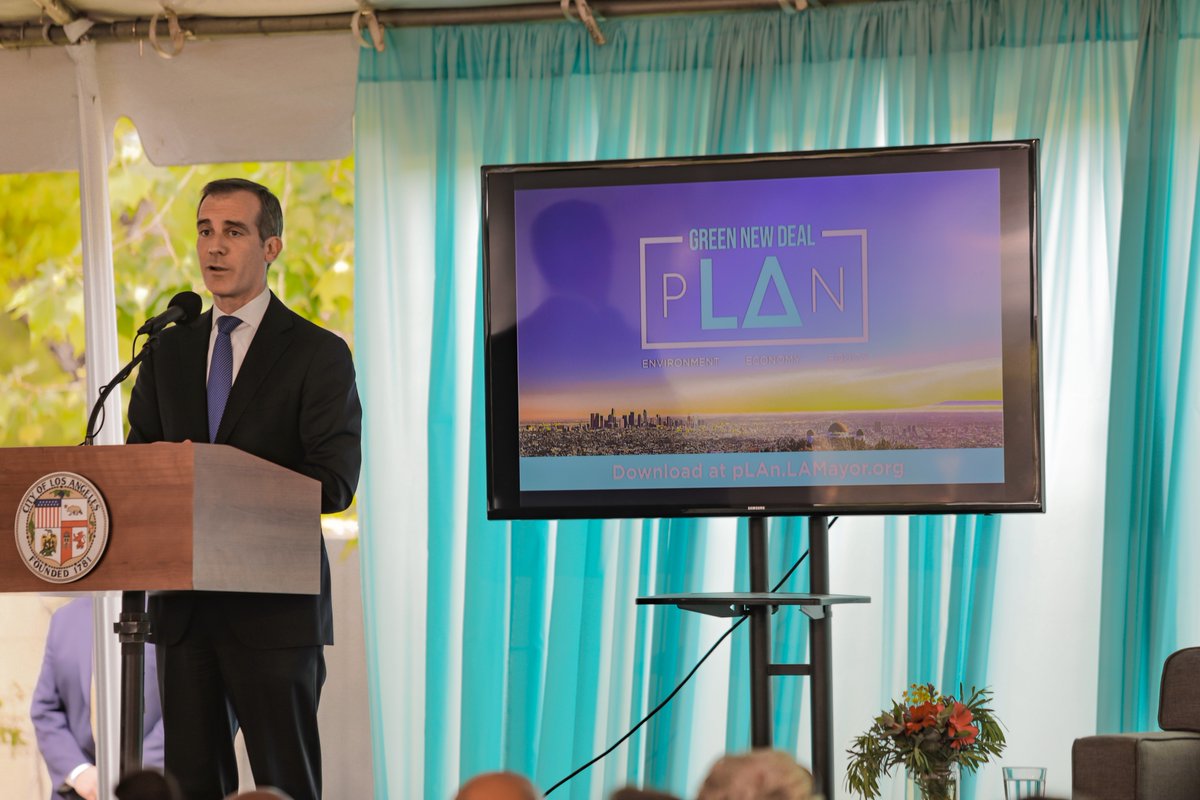 Los Angeles isn’t waiting around on climate change. On Monday, Mayor Eric Garcetti launched the city’s own Green New Deal with a goal of haveing a zero carbon grid, zero carbon transportation, zero carbon buildings, zero waste, and zero wasted water by 2050.
Los Angeles isn’t waiting around on climate change. On Monday, Mayor Eric Garcetti launched the city’s own Green New Deal with a goal of haveing a zero carbon grid, zero carbon transportation, zero carbon buildings, zero waste, and zero wasted water by 2050.
“There is no greater threat to our security, to our economic growth, to the survival of future generations than #ClimateChange. I’m announcing #GreenNewDealLA to lay out an aggressive plan to not just survive global warming, but to ensure that L.A. thrives,” noted the Mayor on his Twitter account.
Solar energy
A big target of that effort will be increasing the output of solar power in the city.
The plan calls for Los Angeles Department of Water and Power (LADWP) to supply 55% of renewable energy by 2025, 80% by 2036, and 100% by 2045.
To achieve this, local solar power must be increased from 900-,1500 MW by 2025 to 1,950 MW by 2050. Energy storage capacity is also to be more than doubled, from 1,654 MW to 4,000 MW in the same period.
But before reaching these targets, the city has to catch up with the rest of the state; LADWP procured only 30% of its electricity from renewables in 2017 – compared to an average of 36% by the state’s three large investor-owned utilities (PG&E, SCE and SDG&E), and 50% by the state’s community choice aggregators.
Additionally, while Los Angeles has the most raw watts of solar panels installed of any U.S. city, its per-capita numbers lag those of San Jose, San Diego and Riverside – the largest cities served by PG&E, SDG&E and SCE respectively.
In his announcement, the Mayor said the plan is not only good for the planet, but for business.
“Going green is good for the planet and for our economy. Our #GreenNewDealLA has already created 35,000 green jobs in just the last few years, and Los Angeles is on track to reach its goal of 400,000 new green jobs by 2050,” he added on Twitter.
Already, Los Angeles has been on a “green” chart.
Four years ago, Mayor Garcetti introduced L.A.’s first Sustainable City pLAn — “a directive that put us on a path to save our environment, grow our economy, and ensure that Los Angeles remains a city of opportunity for all,” he said in a letter attached to the plan.
“Angelenos are already seeing the results. We became the number-one solar city in America, pioneered new transportation technologies, reduced our greenhouse gas emissions by 11% in a single year, and created more than 35,000 green jobs.”
The city will have to move fast to reach some of the goals set forth in the plan.
To do so, they plan to expand the city’s Feed-in Tariff, create new community solar programs for low-income households and renters, launch a virtual net metering pilot program for multifamily housing and require that all new parking structures have solar – all by 2021.
The Mayor may get some help from the state in his efforts. In December, the California Energy Commission approved a plan, in a 5-0 vote, requiring that all newly constructed homes from 2020 on have rooftop solar panels. New home developments are already including them as part of the structure.
You can also do your part. If you want to make the switch to solar power and want to know how much it will cost for your energy needs, you can do it very fast and easily. The Hahasmart price checker gives you this information in a matter of seconds by simply using your address and average monthly utility bill. They’ll recommend what the correct solar power system is for your home to offset those electricity costs, the total cost of equipment and even an estimated cost of installation of your solar panels.
Cities going green
Los Angeles is not alone in its environmental efforts.
According to the Sierra Club, across the U.S. over 90 cities, more than ten counties and two states, have already adopted ambitious 100% clean energy goals. Six cities in the U.S.--Aspen, Burlington, Georgetown, Greensburg, Rock port, and Kodiak Island--have already hit their targets. These six cities now generate 100% of the energy used community-wide from clean, non-polluting and renewable sources.
And every day, more municipalities are also making the commitment.
This is thanks in part to the rapid growth and adaptation of solar power technology, which has been coming down in price dramatically over the last decade.
Solar power is now more affordable and reliable than ever, and - given tax credits and incentives - also more accessible than ever to every homeowner.
In 2016, the average price of a solar power system for an average U.S. home ranged from $11,214 to $14,406. But this varies a lot depending on your energy needs and place of residence.
HahaSmart Blog - More Solar Tips and Guide
HahaSmart News - Stay Informed
Your Solar Incentives - See Credits and Incentives in Your Area
Check Your Home's Solar Price - See How Much You Save
Register Now - Unlock The Lowest Solar Prices in Your Area


Input your address to see if it is solar friendly and how much you can save with solar.
Great. Your address is perfect for solar. Solar incentive is still available. Select monthly utility cost and calculate the size of solar system you will need now.
| kw System size | years Payback period | Lifetime savings |
No money down, 100% finance is available.
|
|
Design the perfect solar system for your home in only a few minutes! |
Comments